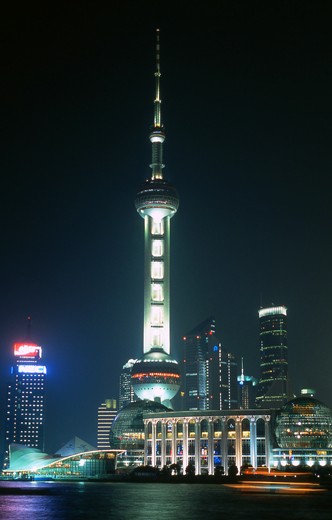Features on Asian Art, Culture, History & Travel
Archives
Archives > CHINA > Shanghai

Shanghai
Soaring Shanghai: A Tale Of Three Cities
SEE RELATED IMAGES @ PICTURES FROM HISTORY
It's hard to believe, but just thirty years ago the Park Hotel, at the junction of Nanjing Road and the Shanghai Bund, was China's tallest building. A visitor gazing across the Huang Pu River eastwards to Pudong would have seen little but rice fields and empty wasteland. Turning south, towards Shanghai Old Town, a depressing vista of run-down tenement buildings and drab back streets would have met the eye. The neon lights of the International Settlement and the French Concession had been dimmed, and the city — home to the ultra-leftist “Gang of Four” — rang harshly to the shrill and ultimately unattainable slogans of the Great Proletarian Cultural Revolution.
Today all this has changed — and almost beyond believing. The Bund has been restored to its former splendour, while the eastern section of Nanjing Road has been transformed into a pedestrian area thronged with Shanghai's conspicuous consumer class. Neon lights are everywhere, shop windows are full, and at night the venerable Bund — Shanghai's internationally famous waterfront — is illuminated with spotlights and revolving lasers.
Eastward, across the Huang Pu River, Pudong now rises like an Oriental Manhattan, featuring some of the tallest and most architecturally innovative buildings in the world. A network of new tunnels, massive suspension bridges and elevated highways carry the city's ever-increasing traffic across or under the river, through Pudong Xinqu, a new extension larger than Shanghai itself, to brand, spanking new Pudong International Airport by the shores of the Yellow Sea.
In the Bund and former International Concessions, the heart of former colonial Shanghai has been restored and, indeed, greatly improved upon. Across the river in Pudong there rises a new, spectacular second city. But what of Old Shanghai, the original settlement, still discernible by the roughly circular road delimiting the former city walls? This, too, is rapidly being restored and redeveloped. The area centred on the famous Huxingting Tea House and Yu Yuan Garden has been rebuilt in “Old Shanghai” style and fairly pulsates with shoppers and sightseers, both local and foreign.
Nearby Fangbang Zhonglu, too, has been restored and is lined with traditional-style Shanghai dumpling houses, bric-a-brac shops and art galleries. Here you can stand beneath red Chinese lanterns casting their glow on an intriguing mix of reproduction 1930s cigarette-girl posters, Chairman Mao memorabilia and other souvenirs — it could almost be the Shanghai of yesteryear, only richer and cleaner. Yet a glance north-eastwards, towards Pudong, reveals a skyscraper skyline dominated by the towering Jin Mao Tower, at 421 metres the third highest building in the world, confirming that this is indeed 21st Century Shanghai.
And the process of renewal and expansion continues apace.
SEE MORE SHANGHAI IMAGES @ PICTURES FROM HISTORY
Text by Andrew Forbes; Photos by David Henley & Pictures From History - © CPA Media
